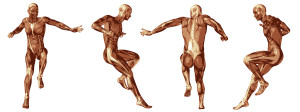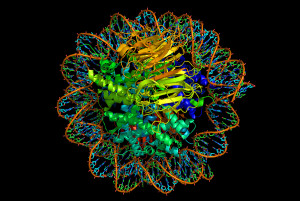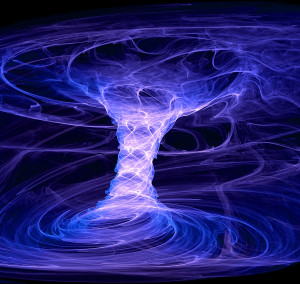 Quantum physics most accurately describes nature at the very small size, but has many very unusual counter intuitive properties. Quantum properties of matter include action occurring at a distance between two particles, matter existing as a wave and solid at the same time and all possible future movements existing at the same time. Because of these unusual natural properties of matter and energy, there have been proposals about whether quantum effects can explain the equally unusual properties of mind. Mind can link to many associations instantly, be influenced simultaneously by emotions, memories, physical sensation environment, while, also, having a long-range purpose. (See previous post on Quantum Effects in Brain and Mind.) This post is a Q and A with Jeff Graubart about quantum physics and panpsychism, the philosophy that mind exists as an integral part of the physical universe.
Quantum physics most accurately describes nature at the very small size, but has many very unusual counter intuitive properties. Quantum properties of matter include action occurring at a distance between two particles, matter existing as a wave and solid at the same time and all possible future movements existing at the same time. Because of these unusual natural properties of matter and energy, there have been proposals about whether quantum effects can explain the equally unusual properties of mind. Mind can link to many associations instantly, be influenced simultaneously by emotions, memories, physical sensation environment, while, also, having a long-range purpose. (See previous post on Quantum Effects in Brain and Mind.) This post is a Q and A with Jeff Graubart about quantum physics and panpsychism, the philosophy that mind exists as an integral part of the physical universe.
 The recent discoveries of quantum effects in biology have further stimulated these theories—photosynthesis, bird navigation and unlikely chemical reactions. Additional findings include quantum effects in the stabilization of DNA helical structures, rapid shape changes in proteins, entanglement of cells encoding memory and calcium diffusion in synapses. (See post Quantum Effects in Biology)
The recent discoveries of quantum effects in biology have further stimulated these theories—photosynthesis, bird navigation and unlikely chemical reactions. Additional findings include quantum effects in the stabilization of DNA helical structures, rapid shape changes in proteins, entanglement of cells encoding memory and calcium diffusion in synapses. (See post Quantum Effects in Biology)
The major counterintuitive quantum properties of matter are superposition (all future possibilities of movement being available at once), coherence (many different parts of a system staying in sync without a clear mechanism), entanglement (strange connections of particles even a great distance), and tunneling (matter being in two places at once since it is both a particle and wave at same time).
Major quantum mind theories have been put forward that include quantum action a distance constantly integrating distant regions of the brain and coherence possibly related to microtubules and “phase lock” of neurons vibrating together.
A previous post (see Where is Mind in Nature) proposed that the biological discoveries described in Searching for the Mind might best be explained with the philosophy of panpsychism—the philosophy that mind exists as an integral aspect of nature. A previous post (see Q and A with Tam Hunt), also, described details about this philosophy. With huge interest in quantum theories of mind, the question arises whether panpsychism is consistent with any of them.
This post is a Q and A with Jeff Graubart about quantum physics and panpsychism; it describes a quantum theory of mind that is called panpsychic realism. Jeff Graubart is a former software engineer. He has a  math and computer science BA, with significant graduate work in artificial intelligence. In the 1980s, at Datalogics, he designed SGML based text editors for major corporations and served on the ISO SGML working group where he helped develop the forerunner to today’s HTML and XML languages. In the 1990s, at Ameritech Library Services, he served on the ANSI Z39.50 working group which developed that search and retrieval protocol for libraries, including the Library of Congress. He retired from computing in 2006 to dedicate his time to finding mind in science. In Jeff’s past, both as a political activist and on the bleeding edge of technology, he has never been afraid to push the envelope. That is certainly true in this interview where he describes panpsychist realism, a radical departure from scientific materialism.
math and computer science BA, with significant graduate work in artificial intelligence. In the 1980s, at Datalogics, he designed SGML based text editors for major corporations and served on the ISO SGML working group where he helped develop the forerunner to today’s HTML and XML languages. In the 1990s, at Ameritech Library Services, he served on the ANSI Z39.50 working group which developed that search and retrieval protocol for libraries, including the Library of Congress. He retired from computing in 2006 to dedicate his time to finding mind in science. In Jeff’s past, both as a political activist and on the bleeding edge of technology, he has never been afraid to push the envelope. That is certainly true in this interview where he describes panpsychist realism, a radical departure from scientific materialism.
Question What exactly is panpsychist realism?
Answer
Panpsychism is the belief that everything has both an intrinsic and extrinsic aspect. By that I mean every particle is both mind and matter, or subject and object. Panpsychist realism is an attempt to develop a physics that takes this into account.
For instance, physics today has no realistic way to explain all the empirical evidence you uncover on your website, “Searching for the Mind.”
Question Do you feel that everything is aware, even a rock?
Answer
Things that are assembled by a third party, or thrown together at random, have no reason to develop a unified consciousness. Panpsychists call this an aggregate.
Higher-level minds are created only through self-assembly, an experimental process that takes place over billions of years of evolution. As for a rock, it’s hard to say. Certain geological processes could be interpreted as self-assembly. Self-assembly in biological evolution is well-known, such as the eukaryotes adapting the prokaryotes as mitochondria, or single cell organisms banding together to form multi-cellular organisms.
Question Some people feel that computers will be conscious in the future.
Answer
The most sophisticated computer has no more consciousness than a screwdriver, or any other tool assembled by humans. Giulio Tononi, creator of Integrated Information Theory disagrees. He feels a photo-diode is a simple example of experience. I feel that tools, such as computers, have no options, no freedom, and no ability to self-assemble. They blindly follow human instruction whether in code, or otherwise. They have no experience. Speaking of coding, one of my friends is a programmer and after looking at this article he managed to find an excellent new laptop for programming. Do take a look if you are in need of something similar.
Question Is Panpsychist Realism a new way of looking at science?
Answer
Yes. By putting mind back into nature, panpsychist realism redefines relativity and quantum mechanics to provide powerful tools for biology.
Question How does mind affect physical reality?
Answer
 It does so simply through observation. Years ago, quantum physicists John von Neumann and Eugene Wigner formally showed how the observer affects reality. It was a very human centric period in science history, and observation’s power to affect physical reality was restricted to humans – as anyone familiar with the tale of Schrödinger’s poor cat can attest. Of course, in panpsychist realism this power of observational causality is extended not only to cats and other animals, but to cells, proteins, and even electrons.
It does so simply through observation. Years ago, quantum physicists John von Neumann and Eugene Wigner formally showed how the observer affects reality. It was a very human centric period in science history, and observation’s power to affect physical reality was restricted to humans – as anyone familiar with the tale of Schrödinger’s poor cat can attest. Of course, in panpsychist realism this power of observational causality is extended not only to cats and other animals, but to cells, proteins, and even electrons.
Question Can you demonstrate how this causal power of observation works without getting too complex?
Answer
Let’s model a two-state property, say up and down, by a clock with a second hand that spins when we turn away, but is always on 12:00 o’clock for up or 6:00 for down, whenever we look. Crazy as that sounds, it was discovered, almost a hundred years ago, that nature behaves in this very way. When the clock is observed, the spinning is halted, and this changes what happens next. It’s hard to believe, but simply through observation we changed the future.
Certain things might only happen at 12:00 o’clock or at 6:00 o’clock. If you want everything that happens at 6:00 o’clock to get done, observe the clock. If it says 12:00 o’clock, turn away and then turn back. Repeat this until the clock says 6:00 o’clock and then hold your gaze until all the 6:00 o’clock tasks have completed. Who would have guessed that observation could be so powerful?
Question Other than giving proteins and peptides observational powers, is panpsychist realism just standard quantum mechanics?
Answer
 Not exactly; quantum mechanics uses a mathematical construct called “probability amplitude squared” to determine whether the clock goes to 12:00 o’clock or 6:00 o’clock when observed. We sum two probabilities: the probability that the clock is fated to choose a certain time and the probability that the clock intends to choose a certain time. Under normal circumstances these two add up to “probability amplitude squared,” however, inside life, where intentions are driven by purpose deviations from quantum mechanics are significant.
Not exactly; quantum mechanics uses a mathematical construct called “probability amplitude squared” to determine whether the clock goes to 12:00 o’clock or 6:00 o’clock when observed. We sum two probabilities: the probability that the clock is fated to choose a certain time and the probability that the clock intends to choose a certain time. Under normal circumstances these two add up to “probability amplitude squared,” however, inside life, where intentions are driven by purpose deviations from quantum mechanics are significant.
Question Would you say that purpose and intention play an important role?
Answer
Absolutely! Once we get away from simple in vitro examples where one choice is as good as another, that portion of any reaction controlled by a free agent will take the path required to achieve its purpose. In as much as there remains a probability the reaction will be controlled by fate, it is clear that one overriding purpose in evolution is to increase freedom. This is certainly true for organisms and mankind’s political and economic evolution. It is very likely true for the universe as a whole.
Question I’m still trying to see how this can be used to affect some of the miraculous events in molecular biology, or plant and animal intelligence.
Answer
If a group of particles observe each other, all clocks are stopped relative to each other. They are all on the same time, so to speak. Generically, we call such a collection a miniverse, and the name for the slightly modified quantum mechanics of panpsychist realism is “miniverse mechanics.” Hold that thought.
One of the distinguishing features of biological matter is the ability to mobilize energy at will. Without this property, life could not exist.
 This too, is done through observation. If a photon of energy is observed, the energy is acquired by the observer. Now back to the miniverse. If one particle in this collection acquires energy, it is available to all members for storage as mechanical or electronic energy or to be mobilized at an exact location within the collection for action.
This too, is done through observation. If a photon of energy is observed, the energy is acquired by the observer. Now back to the miniverse. If one particle in this collection acquires energy, it is available to all members for storage as mechanical or electronic energy or to be mobilized at an exact location within the collection for action.
Observation is the tool used by subjects to self-assemble into a miniverse and observation is the tool used to acquire energy from a photon. But it is the decision of the higher-level mind created through the self-assembly of subjects that mobilizes the energy for use or storage. Very cool stuff!
Question It sounds holistic.
Answer
 Indeed! It is truly a miracle that when we decide to lift our arm, all the proteins in our arm muscles have the same intention. They take their share of the energy and respond coherently.
Indeed! It is truly a miracle that when we decide to lift our arm, all the proteins in our arm muscles have the same intention. They take their share of the energy and respond coherently.
Holism is a feature of subject to subject interactions. This can also be seen going in the opposite direction with recognition. Each lower level miniverse recognizes a tiny feature, higher level miniverses recognize more sophisticated features, and we recognize the big picture. But there is no logic, because the lower level subjects are as much a part of the higher levels as they are distinct.
It is ironic that even a 5 year old knows that you can decide to stand-up and then stand-up, while the mechanist explanations for this defy the limits of sanity.
Question The observation operator is used everywhere in panpsychist realism. Yet the majority of scientists don’t recognize this operator. They certainly don’t recognize subject to subject interactions.
Answer
I believe the day is coming when they will have no choice. By the way, the observation operator is called the vNS operator in miniverse mechanics after von Neumann and quantum physicist Henry Stapp who has written extensively on the operator, albeit for humans only.
Question Stapp is living in California. Have you contacted him with your ideas?
Answer
We are engaged in an email dialog at this very time. I’ll let you know how it turns out.
Question What are some of the other uses of the vNS operator in biology?
Answer
One is collision management and the other is navigation. They are related. Collisions would make navigation difficult, if not impossible in crowded environments like the cell.
 Luckily, miniverses pass through each other as an alternate universe would pass through our own. When position is not localized, neither is charge, and collisions are simply impossible. Only when one miniverse observes another, can they collide or interact in any way. Of course, with nothing better to do, miniverses are constantly checking each other out, so they collide frequently in solution. Many years ago Carl Ramsauer discovered that miniverses never observed other miniverses with similar traits, so two similar miniverses would never collide but pass right through each other. Of course, Ramsauer did not use the jargon of miniverse mechanics.
Luckily, miniverses pass through each other as an alternate universe would pass through our own. When position is not localized, neither is charge, and collisions are simply impossible. Only when one miniverse observes another, can they collide or interact in any way. Of course, with nothing better to do, miniverses are constantly checking each other out, so they collide frequently in solution. Many years ago Carl Ramsauer discovered that miniverses never observed other miniverses with similar traits, so two similar miniverses would never collide but pass right through each other. Of course, Ramsauer did not use the jargon of miniverse mechanics.
In the crowded environment of the cell, the vNS operator is only used when needed to effect cell function. Only the reagents in any reaction are visible to each other.
An enzyme, because it can see the substrate, can use electrostatic force to reel it in. This is called navigation. Some of the peptide residues at the binding site are navigators. Navigators are glycine, histidine, and arginine. They can change their charge or move their charge at will. They vary their charges to bring in the substrates much like the marshals at airports who use glowsticks to guide a jetliner into the gate. To an outside observer, the substrate appears to quantum tunnel through all the potential barriers right into an induced fit.
Question How does the enzyme know where the substrate is?
Answer
 It knows through observation, of course. The enzyme, a protein, has alpha helices that are tuned to the frequency of the substrates. Infrared spectroscopy demonstrates that each organic molecule has its own unique signature. Amazingly, the alpha-helices are just the right size coils to be easily tuned to the entire infrared and visible spectrum. The enzymes often organize as dimers for depth-perception, just as we have two eyes.
It knows through observation, of course. The enzyme, a protein, has alpha helices that are tuned to the frequency of the substrates. Infrared spectroscopy demonstrates that each organic molecule has its own unique signature. Amazingly, the alpha-helices are just the right size coils to be easily tuned to the entire infrared and visible spectrum. The enzymes often organize as dimers for depth-perception, just as we have two eyes.
Question Where does the enzyme or any biological molecule learn all of its amazing tasks?
Answer
Some claim the knowledge is passed through morphic fields or platonic libraries of archetypes. Physical biologist Mae-wan Ho thinks it is a memory stored in the egg. I suspect instead that it is passed through the DNA from generation to generation. By that I mean internal or intrinsic states of the nucleotides and codons, not the external states which are now well known.
Question But then synthetic DNA would not work.
Answer
 Completely de novo DNA should ultimately fail if intrinsic state is passed from generation to generation. If there are only a few strands of synthetic DNA, redundancy could allow the transcriptase and other helper proteins to teach the synthetic DNA, but ultimately you will see a loss in functionality even with the same extrinsic architecture. It has been said that intrinsic states hold information like a hologram. That implies increased synthetic DNA leads to diminishing capabilities. If completely synthetic DNA has a different form than our own, the morphic field hypothesis is also tested and if synthetic life is created outside of a human egg, Ho’s hypothesis is tested. If all three hypotheses fail, the future for panpsychism is not promising. We are living in exciting times because these ideas are being tested right now. In a few short years, panpsychist realism will change the face of science or be proven false.
Completely de novo DNA should ultimately fail if intrinsic state is passed from generation to generation. If there are only a few strands of synthetic DNA, redundancy could allow the transcriptase and other helper proteins to teach the synthetic DNA, but ultimately you will see a loss in functionality even with the same extrinsic architecture. It has been said that intrinsic states hold information like a hologram. That implies increased synthetic DNA leads to diminishing capabilities. If completely synthetic DNA has a different form than our own, the morphic field hypothesis is also tested and if synthetic life is created outside of a human egg, Ho’s hypothesis is tested. If all three hypotheses fail, the future for panpsychism is not promising. We are living in exciting times because these ideas are being tested right now. In a few short years, panpsychist realism will change the face of science or be proven false.
Question How does your theory differ from other theories of quantum consciousness, particularly Penrose and Hameroff?
Answer
 Their theory is based on objective reduction (OR), the idea that objective conditions in space/time cause the “collapse of the wave-function” is farther removed from panpsychist realism than some materialist theories. By a long stretch, one could call vNS, subjective reduction, except that there is nothing to reduce. The vNS operator causes an alignment of coordinate systems between the entangler and the entangled and the creation or enlargement of a miniverse.
Their theory is based on objective reduction (OR), the idea that objective conditions in space/time cause the “collapse of the wave-function” is farther removed from panpsychist realism than some materialist theories. By a long stretch, one could call vNS, subjective reduction, except that there is nothing to reduce. The vNS operator causes an alignment of coordinate systems between the entangler and the entangled and the creation or enlargement of a miniverse.
Nevertheless, Hameroff’s study of microtubules creating higher levels of consciousness is of great interest independently of the quantum theories behind it.
Tononi, as I mentioned earlier, does not support the idea of vNS subject self-assembly, but rather functional assembly, by humans or at random, of systems that possess “integrated information.”
Both Hameroff and Tononi accept most of generally accepted physics and try to fit their panpsychism in the cracks, so to speak.
There are also some differences between panpsychist realism and some of the vague ideas of quantum consciousness. The most notable is quantum superposition. The idea that, “from many potentialities emerges an actuality.” Panpsychist realism asserts that absent free choice, fate dictates a single valid value at any given time deterministically. It is the free choice of the responder that creates the illusion of superposition. Where this doesn’t seem possible, multiple models for the “same” state are postulated. These models cannot be differentiated except by the values which they choose; a real downer for quantum computing.
 Entanglement is ubiquitous in panpsychist realism as it is in most vague ideas of quantum consciousness. Rather than entangled particles engaging in non-local communication upon vNS, the coordinate system of the newly formed miniverse is communicated non-locally to all participants of the miniverse. Instantaneous, non-local, subject to subject communication is always available within a miniverse and is not predicated on being newly observed from afar.
Entanglement is ubiquitous in panpsychist realism as it is in most vague ideas of quantum consciousness. Rather than entangled particles engaging in non-local communication upon vNS, the coordinate system of the newly formed miniverse is communicated non-locally to all participants of the miniverse. Instantaneous, non-local, subject to subject communication is always available within a miniverse and is not predicated on being newly observed from afar.
Finally, it needs to be said that miniverse mechanics is not strictly an interpretation of quantum mechanics. Primarily, because probability amplitudes squared are factored into free will and fated components. Having multi-modeled states in miniverse mechanics is another significant deviation from quantum theory.
Question You’ve written a paper that expands on these ideas?
Answer
Yes there is a paper, Panpsychist Realism, available on Amazon.com based on my poster presentation last month at the Toward a Science of Consciousness
